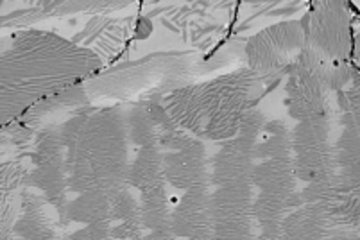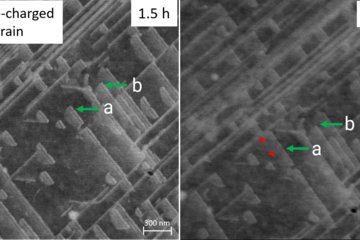All genres
61.
Journal Article
Crystal structures of Fe4C vs. Fe4N analysed by DFT calculations: Fcc-based interstitial superstructures explored. Acta Materialia 140, pp. 433 - 442 (2017)
62.
Journal Article
Strengthening and strain hardening mechanisms in a precipitation-hardened high-Mn lightweight steel. Acta Materialia 140, pp. 258 - 273 (2017)
63.
Journal Article
Operando Phonon Studies of the Protonation Mechanism in Highly Active Hydrogen Evolution Reaction Pentlandite Catalysts. Journal of the American Chemical Society 139 (41), pp. 14360 - 14363 (2017)
64.
Journal Article
Electronic properties, low-energy Hamiltonian, and superconducting instabilities in CaKFe4As4. Physical Review B 96 (9), 094521 (2017)
65.
Journal Article
Effect of Pt substitution on the magnetocrystalline anisotropy of Ni2MnGa: A competition between chemistry and elasticity. Physical Review B 96 (5), 054105, pp. 1 - 6 (2017)
66.
Journal Article
Hydrogen behaviour at twist {110} grain boundaries in alpha-Fe. Philosophical Transactions: Mathematical, Physical and Engineering Sciences 375 (2098), 20160402 (2017)
67.
Journal Article
The role of kappa carbides as hydrogen traps in high-Mn steels. Metals 7 (7), 264 (2017)
68.
Journal Article
Origin of Structural Modulations in Ultrathin Fe Films on Cu(001). Physical Review Letters 118 (23), 236101 (2017)
69.
Journal Article
Phase-field study of ripening and rearrangement of precipitates under chemomechanical coupling. Physical Review B 95 (17), 174101 (2017)
70.
Journal Article
Ab initio explanation of disorder and off-stoichiometry in Fe–Mn–Al–C κ carbides. Physical Review B 95, 104108 (2017)
71.
Journal Article
Low-temperature features in the heat capacity of unary metals and intermetallics for the example of bulk aluminum and Al3Sc. Physical Review B 95, 094307 (2017)
72.
Journal Article
Atomic structures of twin boundaries in hexagonal close-packed metallic crystals with particular focus on Mg. npj Computational Materials 3, 6, pp. 1 - 7 (2017)
73.
Journal Article
Grain boundary diffusion in severely deformed Al-based alloy. Condensed Matter: Materials Science, 06694 (2017)
74.
Journal Article
Leichte Hoch-Mangan-Stähle: Fortschritt durch atomistisches Verständnis. Stahl und Eisen 137 (6), p. 85 - 85 (2017)
75.
Journal Article
Quantenmechanisch geführtes Design von TWIP-Stählen. Stahl und Eisen 137, p. 58 - 58 (2017)
76.
Journal Article
Spin excitations and the Fermi surface of superconducting FeS. npj Quantum Materials 2, 14, pp. 1 - 9 (2017)
77.
Journal Article
Interface effects on the magnetic properties of layered Ni2MnGa/Ni2MnSn alloys: A first-principles investigation. Functional Materials Letters 9 (6), 1642010 (2016)
78.
Journal Article
Interplay between interstitial displacement and displacive lattice transformations. Physical Review B 94 (10), 104109 (2016)
79.
Journal Article
The impact of carbon and oxygen in alpha-titanium: ab initio study of solution enthalpies and grain boundary segregation. Journal of Physics: Condensed Matter 28 (38), 385001 (2016)
80.
Journal Article
Impact of local magnetism on stacking fault energies: A first-principles investigation for fcc iron. Physical Review B 93 (21), 214115 (2016)











